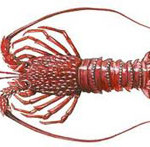
Parechinus angulosus
Sea urchins are often used as indicator organisms in public aquariums to determine whether the system is functioning properly. These organisms are extremely sensitive to water conditions and are first to show signs of stress, seen when their spines are laid down or are shed. Sea urchins are highly sensitive to air and direct sunlight, and often use bits of shell and pebbles as sunshade ‘umbrellas’. Sea urchins (echinoderms) are a group of marine invertebrates that can be found in almost every major marine habitat from the poles to the equator and from the inter-tidal zone to depths of more than 5,000 metres. There are around 800 extant species and the group has a long and detailed fossil record stretching back many millions of years.
All echinoderms have tube-feet and these play a very important role in feeding and respiration. Echinoderms move by means of spines and climb and cling on to hard substrata by means of their tube-feet. The spines also offer the primary means of defence. Sea urchins feed in a variety of ways. They have a powerful internal jaw and graze on algae or sedentary organisms, thanks to a Pumpkin Shell complex system of teeth known as the “lantern of Aristotle”, first described by the Greek philosopher himself, over 2000 years ago. Too much algae threatens corals. If the conditions are right for algae to grow, then the algae can grow over the reef if there aren’t enough algae grazers like the sea urchin to eat them. There needs to be a healthy abundance of algae eaters to keep the corals healthy.
The Cape sea urchin (Parechinus angulosus) is common along the southern African coast. Unlike many tropical urchins, which have lethal spines, the Cape sea urchin’ spines are not poisonous. They are grazing herbivores, scraping algae off the rocks with their beak-like mouths in the middle of the underside. Five double rows of tube feet radiate from the anus down the sides of the shell, which together with their spines, allow them to move. These animals are found in a variety of colours and inhabit the inter-tidal zone. Their greenish skeleton, or test, is often found washed ashore and is referred to locally as pumpkin shell.
Warning! Some sea urchins are covered with sharp venom-filled spines that can easily penetrate and break off into the skin – even through a wetsuit. The DAN (Divers Alert Network) website contains useful information on how to handle the unfortunate effects of accidental brushes with these and other poisonous marine organisms. Check out www.diversalertnetwork.org for any information that you need.








Social Profiles